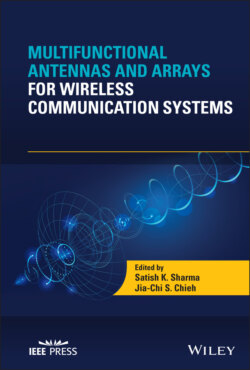Читать книгу Multifunctional Antennas and Arrays for Wireless Communication Systems - Группа авторов - Страница 2
Table of Contents
Оглавление1 Cover
2 Title Page
3 Copyright Page
4 Dedication Page
5 List of Contributors
6 Preface
7 Acknowledgements
8 1 Introduction 1.1 Introduction 1.2 Antenna: an Integral Component of Wireless Communications 1.3 Antenna Performance Parameters 1.4 Antenna Types 1.5 Multifunctional Antennas 1.6 Reconfigurable Antennas 1.7 Frequency Agile/Tunable Antenna 1.8 Antenna Measurements 1.9 Conclusion References
9 2 Frequency Reconfigurable Antennas 2.1 Introduction 2.2 Mechanism of Frequency Reconfigurability 2.3 Types of FRAs 2.4 FRAs in the Future: Applications in Emerging Technologies 2.5 Conclusion References
10 3 Radiation Pattern Reconfigurable Antennas 3.1 Introduction 3.2 Pattern Reconfigurable by Electronically Changing Antenna Elements 3.3 Pattern Reconfigurable by Electronically Changing Feeding Network 3.4 Mechanically Controlled Pattern Reconfigurable Antennas 3.5 Arrays and Optimizations 3.6 Reconfigurable Wearable and Implanted Antennas 3.7 Conclusion References
11 4 Polarization Reconfigurable Antennas 4.1 Introduction 4.2 Polarization Reconfiguration Mechanism Using RF Switches 4.3 Solid‐State RF Switch‐Based Polarization Reconfigurable Antenna 4.4 Mechanical and Micro‐electro‐mechanical (MEMS) RF Switch‐Based Antennas 4.5 Switchable Feed Network‐Based Polarization Reconfiguration 4.6 Polarization Reconfigurable Antennas Using Metasurface 4.7 Other Methods to Create Polarization Reconfigurable Antennas 4.8 Conclusion References
12 5 Liquid Metal, Piezoelectric, and RF MEMS‐Based Reconfigurable Antennas 5.1 Introduction 5.2 Liquid Metal – Frequency Reconfigurable Antennas 5.3 Liquid Metal – Pattern Reconfigurable Antennas 5.4 Liquid Metal – Directivity Reconfigurable Antennas 5.5 Piezoelectric – Pattern Reconfigurable Array 5.6 RF MEMS – Frequency Reconfigurable 5.7 RF MEMS – Polarization Reconfigurable 5.8 RF MEMS – Pattern Reconfigurable 5.9 Conclusion References
13 6 Compact Reconfigurable Antennas 6.1 Introduction 6.2 Reconfigurable Pixel Antenna 6.3 Compact Reconfigurable Antennas Using Fluidic 6.4 Compact Reconfigurable Antennas Using Ferrite and Magnetic Materials 6.5 Metamaterials and Metasurfaces 6.6 Conclusion References
14 7 Reconfigurable MIMO Antennas 7.1 Introduction 7.2 Reconfigurable Antennas for MIMO Applications 7.3 Isolation Techniques in MIMO Antennas 7.4 Pattern Diversity Scheme 7.5 Reconfigurable Polarization MIMO Antenna 7.6 MIMO Antenna Performance Parameters 7.7 Some Reconfigurable MIMO Antenna Examples 7.8 Conclusion References
15 8 Multifunctional Antennas for 4G/5G Communications and MIMO Applications 8.1 Introduction 8.2 MIMO Antennas in Multifunctional Systems 8.3 MIMO Antennas in Radar Systems 8.4 MIMO Antennas in Communication Systems 8.5 MIMO Antennas for Sensing Applications 8.6 MIMO Antennas for 5G Systems 8.7 Massive MIMO Array 8.8 Dielectric Lens for Millimeter Wave MIMO 8.9 Beamforming in Massive MIMO 8.10 MIMO in Imaging Systems 8.11 MIMO Antenna in Medical Applications 8.12 Conclusion References
16 9 Metamaterials in Reconfigurable Antennas 9.1 Introduction 9.2 Metamaterials in Antenna Reconfigurability 9.3 Metamaterial‐Inspired Reconfigurable Antennas 9.4 Metasurface‐Inspired Reconfigurable Antennas 9.5 Conclusion References
17 10 Multifunctional Antennas for User Equipments (UEs) 10.1 Introduction 10.2 Lower/Sub‐6 GHz 5G Band Antennas 10.3 5G mm‐Wave Antenna Arrays 10.4 Collocated Sub‐6 GHz and mm‐Wave 5G Array Antennas 10.5 RF and EMF Exposure Limits 10.6 Conclusion References
18 11 DoD Reconfigurable Antennas 11.1 Introduction 11.2 TACAN 11.3 Sea‐Based X‐Band Radar 1 (SBX‐1) 11.4 The Advanced Multifunction RF Concept (AMRFC) 11.5 Integrated Topside (InTop) 11.6 DARPA Arrays of Commercial Timescales (ACT) 11.7 AFRL Transformational Element Level Array (TELA) 11.8 Conclusion References
19 12 5G Silicon RFICs‐Based Phased Array Antennas 12.1 Introduction 12.2 Silicon Beamformer Technology 12.3 LO‐Based Phase Shifting 12.4 IF‐Based Phase Shifting 12.5 RF‐Based Phase Shifting 12.6 Ku‐Band Phased Arrays Utilizing Silicon Beamforming Chipsets 12.7 Ku‐Band Phased Arrays on ROHACELL Utilizing Silicon Beamforming Chipsets 12.8 Ku‐Band Phased Arrays with Wide Axial Ratios Utilizing Silicon Beamforming Chipsets 12.9 28 GHz Phased Arrays Utilizing Silicon Beamforming Chipsets 12.10 Phased Array Reflectors Utilizing Silicon Beamforming Chipsets 12.11 Conclusion References
20 Index
21 End User License Agreement
